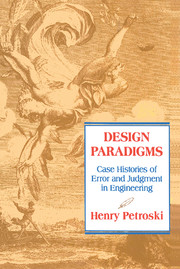Book contents
- Frontmatter
- Contents
- Preface
- 1 Introduction
- 2 Paconius and the Pedestal for Apollo
- 3 Vitruvius's Auger and Galileo's Bones: Paradigms of Limits to Size in Design
- 4 Galileo and the Marble Column
- 5 Galileo's Confirmation of a False Hypothesis
- 6 The Design and Collapse of the Dee Bridge
- 7 The Britannia Tubular Bridge
- 8 Failure as a Source of Engineering Judgment
- 9 The Design Climate for the Tacoma Narrows Bridge
- 10 Historic Bridge Failures and Caveats for Future Designs
- 11 Conclusion
- Bibliography
- Index
6 - The Design and Collapse of the Dee Bridge
A Paradigm of Success Masking Error
Published online by Cambridge University Press: 05 June 2012
- Frontmatter
- Contents
- Preface
- 1 Introduction
- 2 Paconius and the Pedestal for Apollo
- 3 Vitruvius's Auger and Galileo's Bones: Paradigms of Limits to Size in Design
- 4 Galileo and the Marble Column
- 5 Galileo's Confirmation of a False Hypothesis
- 6 The Design and Collapse of the Dee Bridge
- 7 The Britannia Tubular Bridge
- 8 Failure as a Source of Engineering Judgment
- 9 The Design Climate for the Tacoma Narrows Bridge
- 10 Historic Bridge Failures and Caveats for Future Designs
- 11 Conclusion
- Bibliography
- Index
Summary
Except in cases where spectacular public works or loss of life is involved, the details of specific engineering failures are seldom discussed outside the narrow discipline of obvious relevance. Recently, there have been some notable exceptions, of course, including the collapse of the elevated walkways in the Kansas City Hyatt Regency Hotel in 1981 and the explosion of the space shuttle Challenger in 1986. Such colossal failures have been headline news, and few engineers of any discipline are unaware of the most probable causes of the failures, at least in a general sense.
Less spectacular and less recent failures tend to be remembered only within the industry or discipline for which they are perceived to have a continuing relevance, and even then they tend to be relegated to dusty archives as the state of the art appears to eclipse the errant technology that was involved. But a considerable number of failures throughout engineering history have been due to errors in the same timeless design logic and methodology that are used today, and so the root causes of classic failures can and do have a continuing relevance for current designs and design processes of the greatest sophistication and complexity. Furthermore, because lessons drawn from errors in the design process itself necessarily transcend the specific flawed application, failure case histories that are employed as vehicles for conveying the nature of a type of design error have significance for the design process generally and timelessly.
Information
- Type
- Chapter
- Information
- Design ParadigmsCase Histories of Error and Judgment in Engineering, pp. 81 - 98Publisher: Cambridge University PressPrint publication year: 1994
